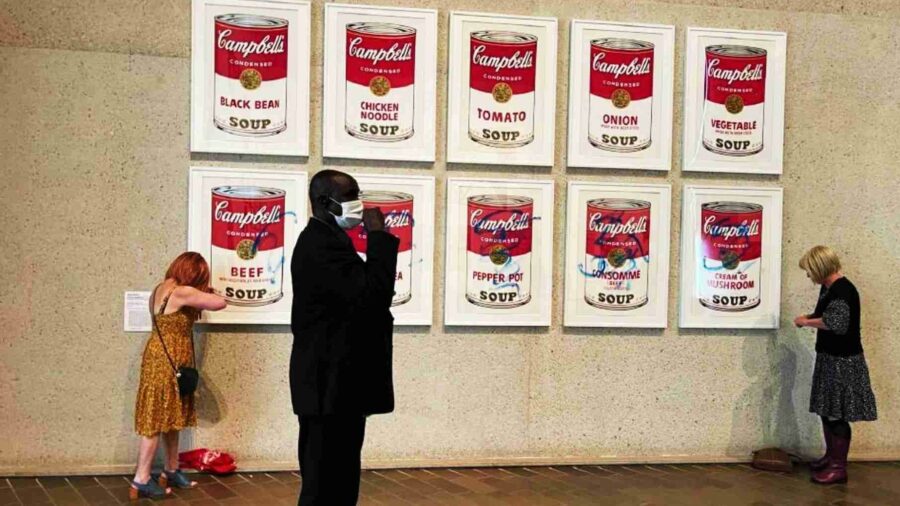
Environmental protest groups have targeted the greatest treasures in art history to raise awareness about climate change.
In recent weeks we have seen how activists from different associations against climate change have vandalised famous works of art in different museums.
This series of acts that, according to them, denounce the global environmental crisis, have managed to attract attention in society, which has caused controversy and has led to questions about whether these actions are really related to the common good.
In the first cases, the activists stuck adhesive to the frames of construction sites or walls around them, but as the days have gone by, they have gradually escalated to throwing different substances such as tomato soup or mashed potatoes.
The various attacks over the past few months
The first case with media coverage was on 14 October when two activists from the group Just Stop Oil threw a can of tomato soup on Van Gogh’s The Sunflowers at the National Gallery in London.
The museum quickly issued a statement clarifying that they only caused minor damage to the frame of the painting, which was protected by glass and unharmed.
But this group did not act alone, their actions have been joined by various associations such as Extinction Rebellion, Letzte Generation from Germany and Ultima Generazione from Italy, and some of them have even received financial support from big businessmen.

Days after the London event, Germany followed in Just Oil’s footsteps; two activists threw mashed potatoes on Monet’s Pajares and then each stuck a hand to the wall around the work. The museum was closed for a week, although the works were not damaged.
Just 13 days later, the Just Oil group struck again, but this time at the Mauritshuis Museum in The Hague, one man stuck his head to the surface of Vermeer’s The Girl with the Pearl while his companion poured tomato soup over his head and shouted:
“How do you feel when you see something beautiful and priceless destroyed seemingly before your eyes?”
Following the incident, officials in The Hague have said that the painting was not damaged and that they are considering new security measures.
The most recent acts in recent days have been perpetrated by a lesser-known Spanish group called Futuro Vegetal, where two young men jumped the queue at the Prado Museum in Madrid and stuck themselves to the frames surrounding two works by Goya: The Dressed Maja and The Naked Maja, in addition, they wrote on the wall “1.5 C” referring to the temperature changes of recent times.
The meadow responded:
“We condemn the act of protest that has taken place in the museum. The works have not been damaged, although the frames are slightly deteriorated. We are working to return to normality as soon as possible: we reject the endangering of cultural heritage as a means of protest”.


Following this, two activists from the Stop Fossil Fuel Subsidies group painted on the glass protecting Andy Warhol’s work and stuck to the famous Campbell’s Soup Cans artwork at the National Gallery in Canberra to demand that the Australian government stop subsidising fossil fuels.
Glue has been a common thread running through all the attacks in recent months, as well as the aim of all activists to direct their anger and protest at historical rather than contemporary works.
In the end, the motivation of the eco-activists involved is to highlight the crisis of climate change, the role of big oil in accelerating environmental degradation and the need to save our planet.
By desecrating something that people associate with value and culture, they are trying to draw attention to the fact that if we don’t have a planet, we will lose all the things we value.
By doing these acts in museums and public galleries, they take it for granted that they will be recorded and broadcast through social media, news outlets, etc. thus fulfilling their goal.

But have these objectives and messages been effective?
They have not really been evident to all viewers, rather than understanding the message they want to convey, they are against it because they see the danger to the works of art and it has been demonstrated that the high security standards that museums have are not sufficient and need to be improved. The protesters are destabilizing the idea that public galleries are safe spaces for such works.
We would be talking about different news if all these works of art had not had showcases to protect them, they would have caused permanent damage to works with a very high monetary and cultural value.
Conclusion:
It is for this type of unpredictable acts that SIT Spain manufactures microclimatic display cases with stable and efficient materials, with a system that provides the best sealing, as well as the safest accessories to preserve the works inside.
These showcases not only serve as physical protection for this type of attacks, but also for the conservation of the conditions required by these works.
Each microclimatic frame is designed and built for its specific work and is manufactured with quality materials in the individual size and shape for the work for which it is intended.
They are elements that help its conservation and avoid alterations, maintaining a stability that guarantees optimal preservation, not to mention additional features such as laminated glass, which provides state-of-the-art anti-reflective security, in addition to a perfect visualization of the work.
SIT has designed, developed and produced museum assemblies for major public and private cultural institutions, which gives us a deep knowledge of the trade.
At SIT we know that attacks on works of art cannot be justified, regardless of whether their motivations are religious, political or cultural, since art represents our shared humanity and a sensitive vision of the world.